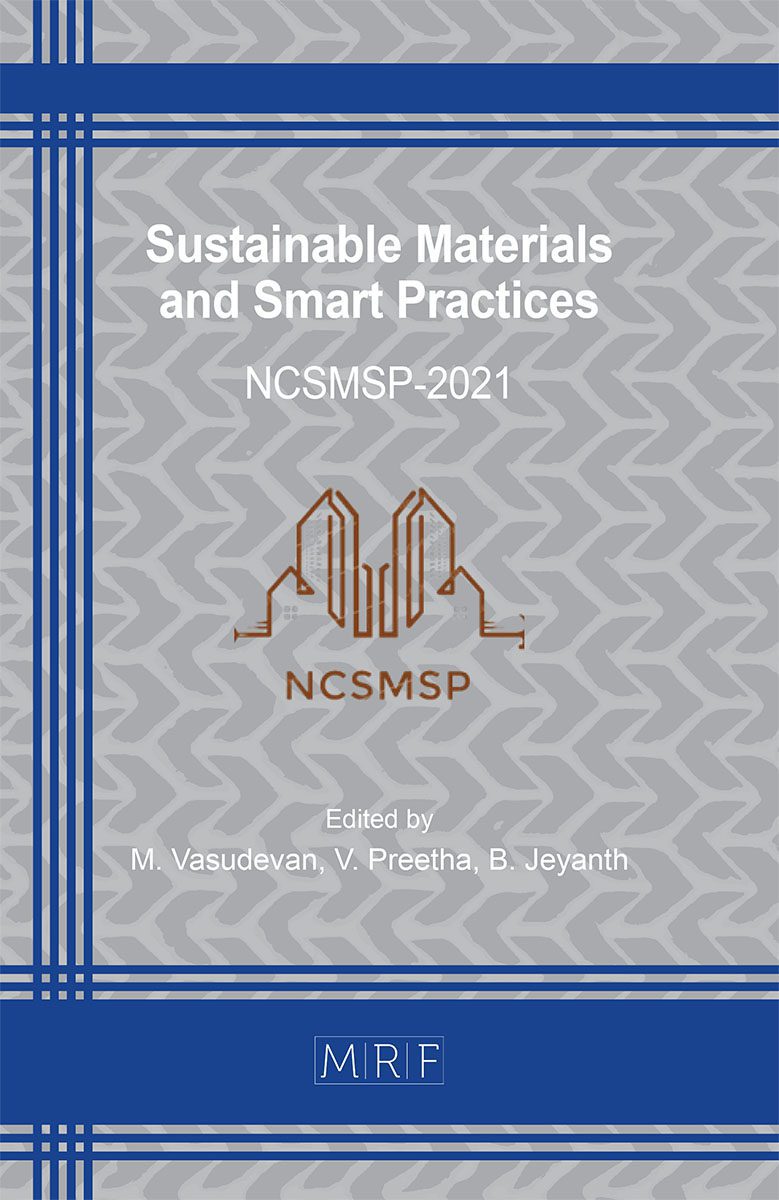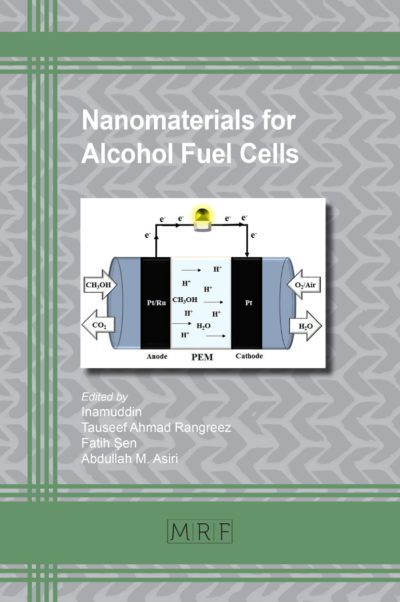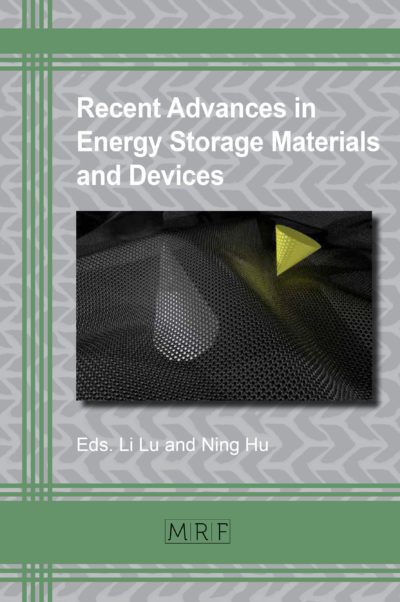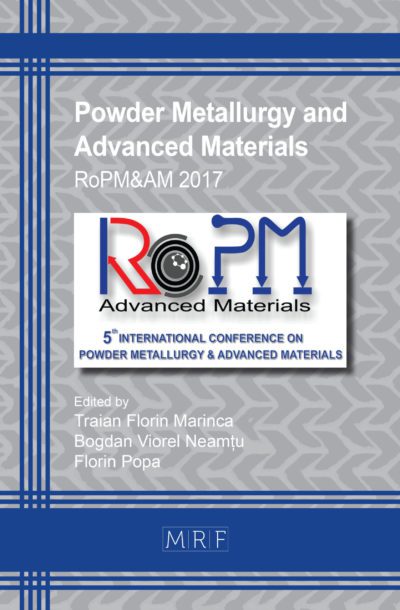Development of Self-Sensing Cement Composite Using Nanomaterials for Structural Health Monitoring of Concrete Columns – A Comprehensive Review
A. Dinesh, A. Mohanraj, S. Veeraraghavan, K.G. Naveena
download PDFAbstract. Due to age, structural deterioration, and other factors, concrete constructions such as beams and columns will inevitably deteriorate. The growth of nanomaterials and recent advances in multidisciplinary research has broadened cement composites’ applicability in various fields. A self-sensing cement composite can detect its own deformation, strain, and stress by changing its electrical characteristics, which may be measured with electrical resistivity. Carbon-based nanomaterials, such as carbon fiber, carbon black, and carbon nanotube, have a strong potential to increase cement composite’s mechanical (strength) and electrical (resistivity, sensitivity) potentials due to their remarkable strength and conductivity. Due to the artificial integration of conductive carbon-based components will generate piezoresistive properties in typical cement composites, transforming them into self-sensing cement composites. As a result, the review focuses primarily on the development of nanoparticle-based self-sensing cement composites and their use in the health monitoring of structural columns. This research critically examines the materials used, fabrication techniques, strength, and sensing methodologies used to develop the self-sensing cement composite. The difficulties of commercializing self-sensing cement composites, as well as potential solutions, are also highlighted. According to the review, the difference in Poisson ratio and youngs modulus between the self-sensing cement composite and columns leads the self-sensing cement composite to have different strength and conductivity before and after embedding in columns. According to the study, the addition of conductive material diminishes the composite’s workability due to its large specific surface area. Because of the well-distributed conductive network, the composite’s resistivity is significantly lowered. The study also shows that the inclusion of a self-sensing cement composite has no bearing capacity influence on the column. Finally, according to the review, the self-sensing cement composite has the ability to monitor the health of structural columns.
Keywords
Self-Sensing, Nanomaterials, Carbon, Health Monitoring, Strength and Conductivity
Published online , 14 pages
Copyright © 2022 by the author(s)
Published under license by Materials Research Forum LLC., Millersville PA, USA
Citation: A. Dinesh, A. Mohanraj, S. Veeraraghavan, K.G. Naveena, Development of Self-Sensing Cement Composite Using Nanomaterials for Structural Health Monitoring of Concrete Columns – A Comprehensive Review, Materials Research Proceedings, Vol. 23, pp 191-204, 2022
DOI: https://doi.org/10.21741/9781644901953-23
The article was published as article 23 of the book Sustainable Materials and Smart Practices
![]() Content from this work may be used under the terms of the Creative Commons Attribution 3.0 licence. Any further distribution of this work must maintain attribution to the author(s) and the title of the work, journal citation and DOI.
Content from this work may be used under the terms of the Creative Commons Attribution 3.0 licence. Any further distribution of this work must maintain attribution to the author(s) and the title of the work, journal citation and DOI.
References
[1] A. Dinesh, R. Prasanth Kumar, S.R. Abijith, Experimental investigation on bubble deck concrete using plastic waste, 2020. https://doi.org/10.1007/978-981-15-0990-2_14.
[2] J.M. Rius, A. Cladera, C. Ribas, B. Mas, Shear strengthening of reinforced concrete beams using shape memory alloys, Constr. Build. Mater. 200 (2019) 420–435. https://doi.org/10.1016/j.conbuildmat.2018.12.104.
[3] A. Professor, Study on Strength properties of High performance concrete, n.d. www.ripublication.com/ijaer.htm.
[4] A.S. S.D., D. A., S.B. V., Investigation of waste marble powder in the development of sustainable concrete, Mater. Today Proc. (2020). https://doi.org/10.1016/j.matpr.2020.10.536.
[5] P. Eswaramoorthi, P. Magudeaswaran, A. Dinesh, PUSHOVER ANALYSIS OF STEEL FRAME, n.d.
[6] A. Professor, Analytical study on the behaviour of cold formed steel double channel beam sections, n.d. www.ripublication.com/ijaer.htm.
[7] M. Sutcu, H. Alptekin, E. Erdogmus, Y. Er, O. Gencel, Characteristics of fired clay bricks with waste marble powder addition as building materials, Constr. Build. Mater. 82 (2015) 1–8. https://doi.org/10.1016/j.conbuildmat.2015.02.055.
[8] D. Sellakutty, A. Professor, UTILISATION OF WASTE PLASTIC IN MANUFACTURING OF BRICKS AND PAVER BLOCKS, 2016. https://www.researchgate.net/publication/303273892.
[9] K. Sathish Raja, Dinesh. A, Study on Self Compacting Concrete – A Review, Int. J. Eng. Res. V5 (2016). https://doi.org/10.17577/ijertv5is020349.
[10] A. Professor, Stabilization of soil by using solid waste-A Review, © 2017 IJEDR |. 5 (2017). www.ijedr.org.
[11] Individual_chapter.pdf, (n.d.).
[12] A. Dinesh, S. Harini, J.P. Jasmine, J. Jincy, J. Shagufta, International journal of engineering sciences & research technology experimental study of blast furnace slag concrete, Int. J. Eng. Sci. Res. Technol. 6 (2017) 42–50. https://doi.org/10.5281/zenodo.345692.
[13] A. Dehghani, F. Aslani, The effect of shape memory alloy, steel, and carbon fibres on fresh, mechanical, and electrical properties of self-compacting cementitious composites, Cem. Concr. Compos. 112 (2020) 103659. https://doi.org/10.1016/j.cemconcomp.2020.103659.
[14] X. Xi, D.D.L. Chung, Piezoelectret-based and piezoresistivity-based stress self-sensing in steel beams under flexure, Sensors Actuators, A Phys. 301 (2020) 111780. https://doi.org/10.1016/j.sna.2019.111780.
[15] Y. Zhang, L. Yuan, Z. Zhou, A. Kaur, Sensors for Structural Health Monitoring in Civil Infrastructure, J. Sensors. 2018 (2018) 1–2. https://doi.org/10.1155/2018/6023059.
[16] Y. Chen, Y. Wen, P. Li, Characterization of PZT ceramic transducer embedded in concrete, Sensors Actuators, A Phys. 128 (2006) 116–124. https://doi.org/10.1016/j.sna.2006.01.001.
[17] Y.H. Huang, L. Liu, F.C. Sham, Y.S. Chan, S.P. Ng, Optical strain gauge vs. traditional strain gauges for concrete elasticity modulus determination, Optik (Stuttg). 121 (2010) 1635–1641. https://doi.org/10.1016/j.ijleo.2009.03.002.
[18] A. Dinesh, S.T. Sudharsan, S. Haribala, Self-sensing cement-based sensor with carbon nanotube: Fabrication and properties – A review, Mater. Today Proc. (2021). https://doi.org/10.1016/j.matpr.2021.02.722.
[19] T. Shi, Z. Li, J. Guo, H. Gong, C. Gu, Research progress on CNTs/CNFs-modified cement-based composites – A review, Constr. Build. Mater. 202 (2019) 290–307. https://doi.org/10.1016/j.conbuildmat.2019.01.024.
[20] A. Dinesh, B. Abirami, G. Moulica, Materials Today : Proceedings Carbon nanofiber embedded cement composites : Properties and promises as sensor – A review, Mater. Today Proc. (2020). https://doi.org/10.1016/j.matpr.2020.10.526.
[21] R.K. Biswas, F. Bin Ahmed, M.E. Haque, A.A. Provasha, Z. Hasan, F. Hayat, D. Sen, Effects of Steel Fiber Percentage and Aspect Ratios on Fresh and Harden Properties of Ultra-High Performance Fiber Reinforced Concrete, Appl. Mech. 2 (2021) 501–515. https://doi.org/10.3390/applmech2030028.
[22] G. Batson, Steel fiber reinforced concrete, Mater. Sci. Eng. 25 (1976) 53–58. https://doi.org/10.1016/0025-5416(76)90051-3.
[23] S. Wen, D.D.L. Chung, Carbon fiber-reinforced cement as a strain-sensing coating, 31 (2001) 665–667.
[24] S. Wen, D.D.L. Chung, Strain-Sensing Characteristics of Carbon Fiber-Reinforced Cement, (2006) 2006.
[25] E. Hammel, X. Tang, M. Trampert, T. Schmitt, K. Mauthner, A. Eder, P. Pötschke, Carbon nanofibers for composite applications, Carbon N. Y. 42 (2004) 1153–1158. https://doi.org/10.1016/j.carbon.2003.12.043.
[26] I. Kang, Y.Y. Heung, J.H. Kim, J.W. Lee, R. Gollapudi, S. Subramaniam, S. Narasimhadevara, D. Hurd, G.R. Kirikera, V. Shanov, M.J. Schulz, D. Shi, J. Boerio, S. Mall, M. Ruggles-Wren, Introduction to carbon nanotube and nanofiber smart materials, Compos. Part B Eng. 37 (2006) 382–394. https://doi.org/10.1016/j.compositesb.2006.02.011.
[27] S. Ding, Y. Ruan, X. Yu, B. Han, Y.Q. Ni, Self-monitoring of smart concrete column incorporating CNT/NCB composite fillers modified cementitious sensors, Constr. Build. Mater. 201 (2019) 127–137. https://doi.org/10.1016/j.conbuildmat.2018.12.203.
[28] W. Li, W. Dong, L. Shen, A. Castel, S.P. Shah, Conductivity and piezoresistivity of nano-carbon black (NCB) enhanced functional cement-based sensors using polypropylene fibres, Mater. Lett. 270 (2020) 127736. https://doi.org/10.1016/j.matlet.2020.127736.
[29] B. Han, K. Zhang, X. Yu, E. Kwon, J. Ou, Nickel particle-based self-sensing pavement for vehicle detection, Meas. J. Int. Meas. Confed. 44 (2011) 1645–1650. https://doi.org/10.1016/j.measurement.2011.06.014.
[30] K. Zhang, B. Han, X. Yu, Nickel particle based electrical resistance heating cementitious composites, Cold Reg. Sci. Technol. 69 (2011) 64–69. https://doi.org/10.1016/j.coldregions.2011.07.002.
[31] S.Y. Lee, H.V. Le, D.J. Kim, Self-stress sensing smart concrete containing fine steel slag aggregates and steel fibers under high compressive stress, Constr. Build. Mater. 220 (2019) 149–160. https://doi.org/10.1016/j.conbuildmat.2019.05.197.
[32] B. Han, S. Ding, X. Yu, Intrinsic self-sensing concrete and structures: A review, Meas. J. Int. Meas. Confed. 59 (2015) 110–128. https://doi.org/10.1016/j.measurement.2014.09.048.
[33] L. Shi, Y. Lu, Y. Bai, Mechanical and Electrical Characterisation of Steel Fiber and Carbon Black Engineered Cementitious Composites, Procedia Eng. 188 (2017) 325–332. https://doi.org/10.1016/j.proeng.2017.04.491.
[34] L. Zhang, B. Han, J. Ouyang, X. Yu, S. Sun, J. Ou, Multifunctionality of cement based composite with electrostatic self-assembled CNT/NCB composite filler, Arch. Civ. Mech. Eng. 17 (2017) 354–364. https://doi.org/10.1016/j.acme.2016.11.001.
[35] S.J. Lee, I. You, G. Zi, D.Y. Yoo, Experimental investigation of the piezoresistive properties of cement composites with hybrid carbon fibers and nanotubes, Sensors (Switzerland). 17 (2017). https://doi.org/10.3390/s17112516.
[36] H.B. Birgin, S. Laflamme, A. D’alessandro, E. Garcia-Macias, F. Ubertini, A weigh-in-motion characterization algorithm for smart pavements based on conductive cementitious materials, Sensors (Switzerland). 20 (2020). https://doi.org/10.3390/s20030659.
[37] P. Park, Y. Rew, A. Baranikumar, Controlling conductivity of asphalt concrete with graphite, 7 (2014) 106.
[38] S. Wen, D.D.L. Chung, Piezoresistivity-based strain sensing in carbon fiber-reinforced cement, ACI Mater. J. 104 (2007) 171–179. https://doi.org/10.14359/18580.
[39] H. Deng, H. Li, Assessment of self-sensing capability of Carbon Black Engineered Cementitious Composites, Constr. Build. Mater. 173 (2018) 1–9. https://doi.org/10.1016/j.conbuildmat.2018.04.031.
[40] O. Galao, F.J. Baeza, E. Zornoza, P. Garcés, Strain and damage sensing properties on multifunctional cement composites with CNF admixture, Cem. Concr. Compos. 46 (2014) 90–98. https://doi.org/10.1016/j.cemconcomp.2013.11.009.
[41] G. Yıldırım, M.H. Sarwary, A. Al-Dahawi, O. Öztürk, Ö. Anıl, M. Şahmaran, Piezoresistive behavior of CF- and CNT-based reinforced concrete beams subjected to static flexural loading: Shear failure investigation, Constr. Build. Mater. 168 (2018) 266–279. https://doi.org/10.1016/j.conbuildmat.2018.02.124.
[42] X. Xin, M. Liang, Z. Yao, L. Su, J. Zhang, P. Li, C. Sun, H. Jiang, Self-sensing behavior and mechanical properties of carbon nanotubes/epoxy resin composite for asphalt pavement strain monitoring, Constr. Build. Mater. 257 (2020) 119404. https://doi.org/10.1016/j.conbuildmat.2020.119404.
[43] A. Yazdanbakhsh, Z. Grasley, B. Tyson, R.K. Abu Al-Rub, Distribution of carbon nanofibers and nanotubes in cementitious composites, Transp. Res. Rec. (2010) 89–95. https://doi.org/10.3141/2142-13.
[44] Y. Wang, Y. Wang, B. Wan, B. Han, G. Cai, Z. Li, Properties and mechanisms of self-sensing carbon nanofibers/epoxy composites for structural health monitoring, Compos. Struct. 200 (2018) 669–678. https://doi.org/10.1016/j.compstruct.2018.05.151.
[45] B. Han, L. Zhang, S. Sun, X. Yu, X. Dong, T. Wu, J. Ou, Electrostatic self-assembled carbon nanotube/nano carbon black composite fillers reinforced cement-based materials with multifunctionality, Compos. Part A Appl. Sci. Manuf. 79 (2015) 103–115. https://doi.org/10.1016/j.compositesa.2015.09.016.
[46] Y. Ding, Z. Chen, Z. Han, Y. Zhang, F. Pacheco-Torgal, Nano-carbon black and carbon fiber as conductive materials for the diagnosing of the damage of concrete beam, Constr. Build. Mater. 43 (2013) 233–241. https://doi.org/10.1016/j.conbuildmat.2013.02.010.
[47] Q. Liu, W. Wu, J. Xiao, Y. Tian, J. Chen, A. Singh, Correlation between damage evolution and resistivity reaction of concrete in-filled with graphene nanoplatelets, Constr. Build. Mater. 208 (2019) 482–491. https://doi.org/10.1016/j.conbuildmat.2019.03.036.
[48] H. Siad, M. Lachemi, M. Sahmaran, H.A. Mesbah, K.A. Hossain, Advanced engineered cementitious composites with combined self-sensing and self-healing functionalities, Constr. Build. Mater. 176 (2018) 313–322. https://doi.org/10.1016/j.conbuildmat.2018.05.026.

































